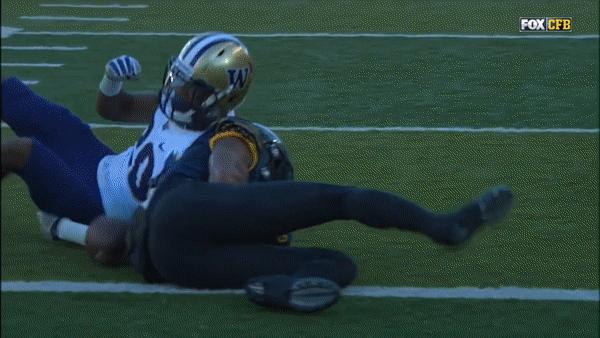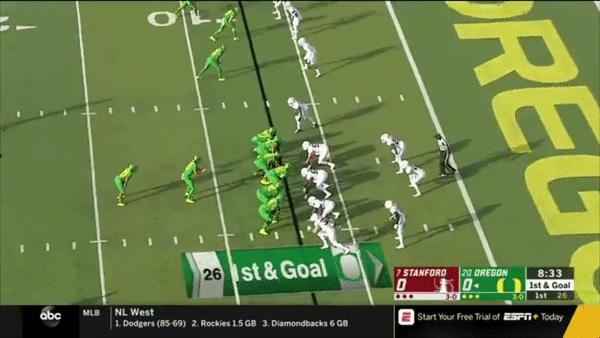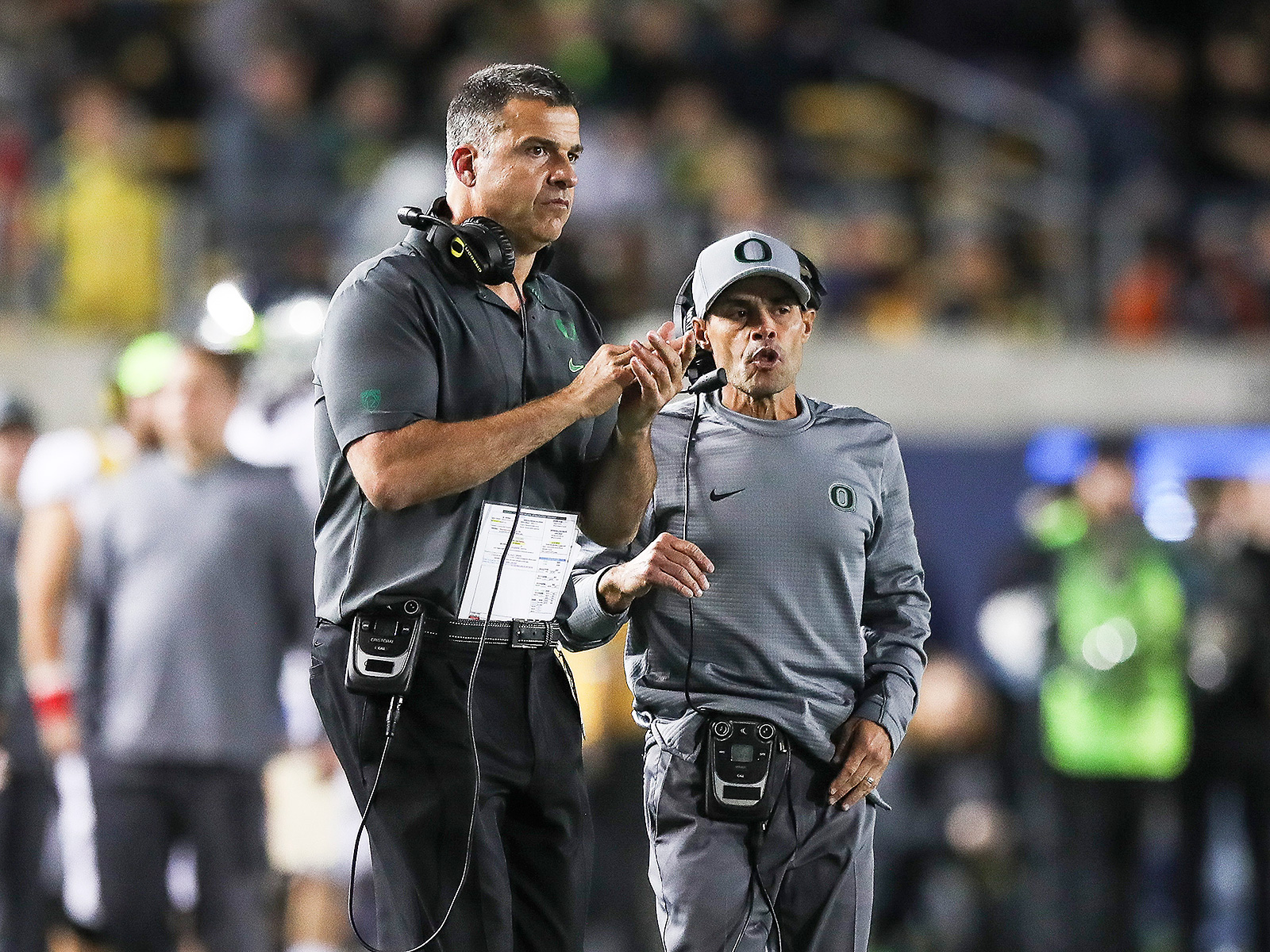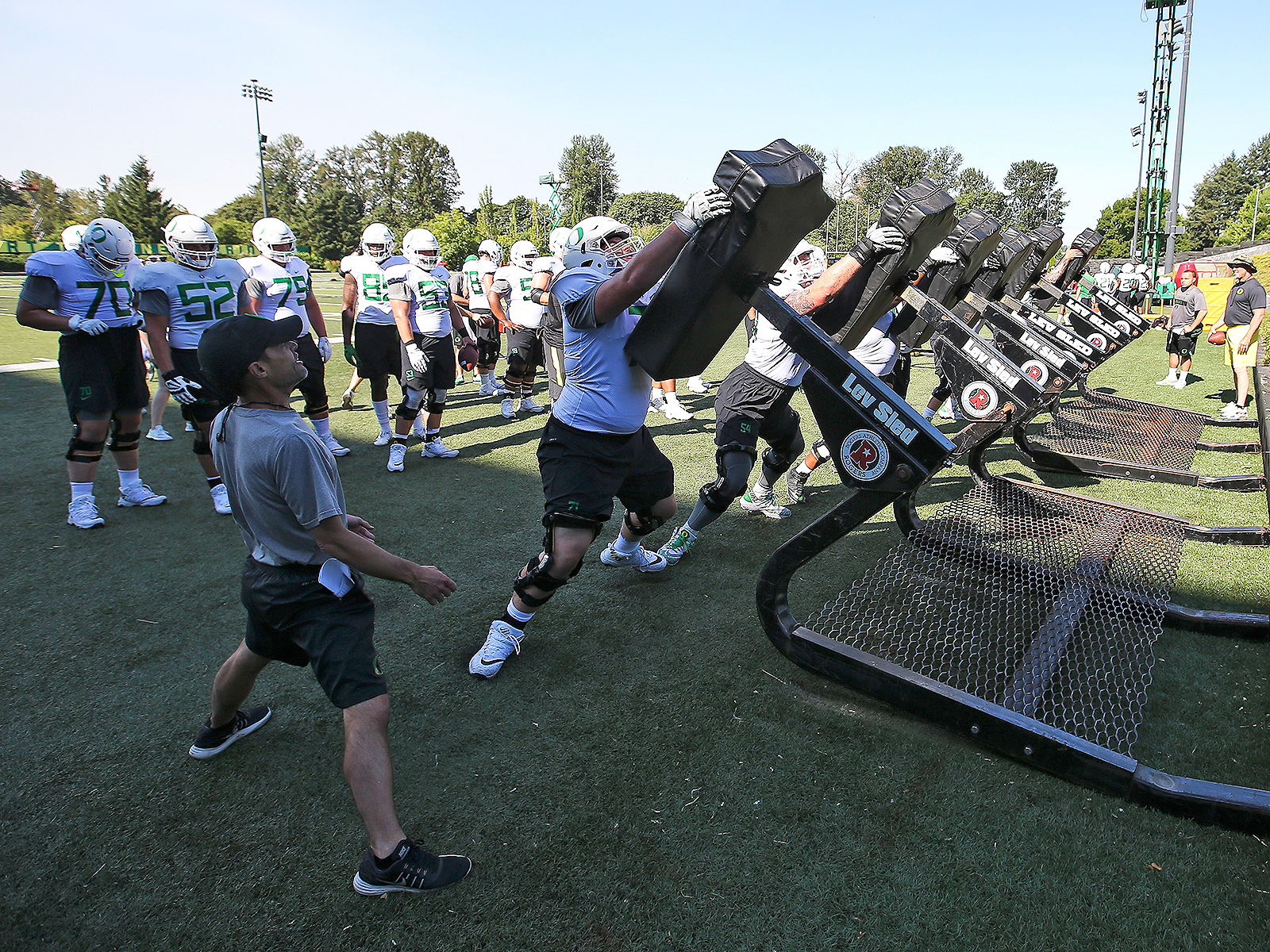Mario Cristobal Has Oregon Outside of Its Brand and Ahead of Schedule

EUGENE, Ore. — Mario Cristobal has a huge smile on his face. He’s imagining something that will never happen, but a man can dream.
“Wouldn’t the world be a better place,” the first-year Oregon coach says, “if everyone acted like offensive linemen?”
He’s not wrong. At least if he’s talking about the best offensive linemen. They’re big, strong and not worried about who gets the credit. They’re concerned mainly with accomplishing the assigned task and helping their teammates prosper. They’re loyal, and they’re willing to be uncomfortable for the sake of the cause. Sure, we might need to find a way to produce more food to keep this utopia humming, but it would be an XXXXXXXL paradise where no one ever whines except when the training table runs out of chicken wings.
Cristobal may not have to imagine, though. He’s trying to create such a place in the Pacific Northwest. A star offensive tackle from Miami’s glory days who grew into one of the nation’s most revered O-line coaches, Cristobal would love nothing more than an entire team of players who think and act like offensive linemen, and that team would just so happen to have a premium offensive line paving the way. If this sounds like blasphemy in the place where Chip Kelly revolutionized offensive football in the not-too-distant past, it shouldn’t. This is about survival, and it’s also about the only way Cristobal knows to succeed.
Kelly did change everything in his time as offensive coordinator at Oregon, but in the time between his departure for the Philadelphia Eagles and now, the Pac-12 changed around the Ducks. When Kelly was in Eugene, his blur offense decimated most of the Pac-12. It struggled at times against Stanford and its culture of “intellectual brutality,” but Oregon was so successful in that span that nearly every program in college football borrowed at least one piece of what Oregon was doing.
How Laviska Shenault Jr.'s Life of Competition and Perseverance Have Led Him to the Spotlight
Still, the Cardinal and their heavy jumbo sets had a foothold. And then in late 2014, Washington hired Chris Petersen, another coach who preferred to bludgeon opponents at the line of scrimmage. With Oregon quarterback Marcus Mariota on his way to the NFL after leading Oregon to the national title game, the Pac-12 North was about to turn from green and yellow to black and blue. Stanford and Washington would rule instead. The Cardinal’s pin-and-pull blocking schemes and the Huskies’ ability to put two defensive tackles on the field who could occupy four blockers shifted the paradigm. The North became a line of scrimmage division at the moment Oregon was about to be very depleted on both lines.
The nadir for the Ducks was Washington’s last trip to Eugene in 2016. In Oregon quarterback Justin Herbert’s first career start, the Huskies manhandled the Ducks, 70–21. Washington hadn’t beaten Oregon in this bitter rivalry since 2003, but the Huskies were a team bound for a Pac-12 title and a College Football Playoff berth and the Ducks were a team destined to fire coach Mark Helfrich. Washington players took out a generation’s worth of frustration on the Ducks that day. “Seventy-seven would've been cool, too,” Huskies quarterback Jake Browning told reporters. “The more points you can score the better.”
On that day, it seemed like Oregon would need years to fix. Petersen and Stanford’s David Shaw had established the new blueprint for winning in the Pac-12, and Oregon looked as far behind as all those hapless conference opponents did when they played the Ducks in the Kelly era. Oregon would need to upgrade its offensive and defensive lines while still bringing in the kind of skill position players that made Kelly’s offense thrive.
But when Washington returns to Autzen Stadium on Saturday, the Huskies will find an Oregon team that isn’t completely overhauled but may still be good enough to compete for a Pac-12 title. The Ducks didn’t quite look ready when they gagged away a 24–7 halftime lead and fell in overtime against Stanford on Sept. 22, but they still have a chance to play their way back in the race. Saturday’s result will provide us with a more definitive gauge of where Oregon stands. The Ducks are playing for their third head coach in three years, and while that usually signals chaos, Cristobal and his staff—many of whom (including the head coach and defensive coordinator Jim Leavitt) were on Willie Taggart’s staff last season—have already improved the Ducks in the trenches on both sides of the ball thanks to a group of players who got abused by opponents as youngsters in Helfrich’s last season. Add in a transcendent quarterback who will face a difficult decision at the end of this season, and the Ducks may not be a year or two away. The window may be open now.
Herbert accelerated the rebuild. He made that first career start two years ago as a 6’ 6”, 210-pound slinger with obvious raw talent but plenty of room for improvement. He’ll make his second start against the Huskies—he missed last year’s 38–3 loss in Seattle with a broken collarbone—as a 233-pound grown man who can beat opponents with his arm or with his legs and who may also be the No. 1 pick in the 2019 NFL draft (if Herbert, a Eugene native, chooses to leave instead of staying for his senior year to play with his brother, a 2019 tight end commit). Meanwhile, Herbert will have a trio of blockers in front of him who haven’t forgotten getting pounded by Washington.
Left guard Shane Lemieux, center Jake Hanson and right tackle Calvin Throckmorton all started against Washington that day. On Saturday, the group will start its 31st game together. That figure includes some humiliating on-the-job training as the Ducks went 4–8 when the three were redshirt freshmen. “That’s a testament to their toughness,” Oregon offensive line coach Alex Mirabal says. “When I’m talking about toughness, I’m talking not just physical but mental toughness. Those guys have all had bumps, bruises, injuries that they have chosen to play through. A true sign of toughness is continuing to do your job. I guarantee those jokers don’t always feel 100%.”
But the development has been obvious. Here’s a representative play from 2016.

Here’s one from earlier this season.

Oregon’s offensive line gets plenty of attention in practice. Cristobal was the group’s position coach last season, and he still spends much of the individual and group periods with the line. But as head coach, he can’t focus solely on one group. That’s why after he was elevated from interim head coach in December, Cristobal called the only person he knows will teach offensive line play exactly as he wants it taught—his former Miami Columbus High linemate.
Cristobal and Mirabal met in the spring of Cristobal’s freshman year at Columbus and have been friends ever since. They made quite a pair playing alongside one another on the line. Cristobal was the 6’5” future Hurricane who eventually would weigh more than 330 pounds. Mirabal was 5’5”. When he discovered football, he weighed 150 pounds. “I fell in love with offensive line play and the intricacy of offensive line play,” Mirabal says. “Choreographing five individuals to play with one mind and one body intrigued me.” He bulked up to 200 pounds to play guard at Columbus, making him huge for a guy his height. “One of our strongest guys in the weight room,” Cristobal says.

That extra weight is long gone now. Mirabal runs five or six miles a day. Most of the players he coaches are a foot taller and 150 pounds heavier than he is. But a career spent coaching offensive lines at the high school level in Miami and then at Florida International—where Cristobal was the head coach—and Marshall have proven that you don’t have to look like an NFL center to help a young center develop into an NFL player. Mirabal’s transition to Oregon was easy because after a season with Cristobal, the Ducks’ linemen already understood what Mirabal would expect from them. There were no surprises when he wanted them hitting the sled and drilling in the chute—a contraption that forces linemen to play with low pad level lest they whack their heads on its roof—every Tuesday and Wednesday practice. “Physically, you can see the difference now this year,” Mirabal says. “Those values, that philosophy, that mentality that coach Cristobal spoke to them about last year—that they tried to put into action last year—you can actually see it being put into effect on the field.”
It also helps that Cristobal has added talent to the group. Left tackle Penei Sewell, a 345-pound true freshman from St. George, Utah, was a starter from the moment he stepped on campus. He’ll likely be a first-rounder if he chooses to leave after his junior season. He’s also the vanguard for the next generation of offensive linemen at Oregon. Sewell was on Cristobal’s radar when Cristobal served as Alabama’s offensive line coach. When Cristobal got to Oregon, he made Sewell a priority. Cristobal also signed four other offensive linemen in the 2018 class. He hopes to redshirt them if the trio of redshirt juniors and Alabama grad transfer Dallas Warmack can stay healthy, but Sewell was simply too good to keep off the field.
One misconception about the Oregon teams of the Kelly/Helfrich era was that the Ducks played a finesse brand of offense. Their scheme actually placed extreme value on runs between the tackles—because success there tended to make receivers wide open following play-action fakes—but they couldn’t consistently recruit high level offensive linemen. There were a few excellent ones such as guard Kyle Long, center Hroniss Grasu and tackles Jake Fisher and Tyrell Crosby, but Oregon wasn’t an offensive line factory. Case in point: When Kelly led Oregon to the BCS title game following the 2010 season, the Ducks had no one who could block Auburn defensive tackle Nick Fairley. So Kelly decided the Ducks would leave Fairley unblocked and read him on read option plays. Unfortunately for Oregon, Fairley was so athletic that he could diagnose the play and tackle the quarterback and tailback while they were meshed together. A team with a line as athletic as the ones at Alabama, Georgia or Ohio State could adjust to that, but Oregon had no answer.
With Cristobal choosing the linemen, that may change. He’ll focus primarily on the West Coast, but he’ll go anywhere for a guy who can block. The Ducks’ 2019 recruiting class—currently ranked No. 1 in the Pac-12 and No. 4 in the nation by 247Sports—includes a commitment from 6’7”, 345-pounder Malaesala Aumavae-Laulu, who plays at Navarro College in Corsicana, Texas, and who is the nation’s top juco line prospect.
Taggart’s departure to Florida State after less than a calendar year in Eugene and Cristobal’s subsequent—and sudden—promotion from offensive coordinator/line coach to head coach might suggest a stopgap to maintain some continuity for Ducks players who have been put through the coaching wringer. But like a certain coach on the East Coast who will celebrate the 10th anniversary of being bumped from receivers coach to interim head coach on Saturday, it may turn out Cristobal was the best choice for the Ducks all along.
Only FIU fans and pure college football nerds followed Cristobal’s tenure with the Golden Panthers, but it was far better than its ending suggests. At age 36, Cristobal inherited a team that had gone winless in 2006. After going 1–11, 5–7 and 3–9 in his first three seasons, Cristobal led FIU to a Sun Belt Conference title in 2010. It was the first winning season in program history. Cristobal followed that with an 8–5 record in 2011, but he was fired after the Panthers fell to 3–9 in 2012. What the records don’t show is how comically inept FIU’s athletic department has been historically and how good Cristobal’s eye for talent was even as a young head coach. Those FIU staffs included current Temple head coach Geoff Collins, current Texas defensive coordinator Todd Orlando and current Appalachian State head coach Scott Satterfield.
The staffing piece was what impressed Oregon athletic director Rob Mullens when he began digging into Cristobal’s history as a head coach while trying to decide what to do after Taggart, the coach he hired for a rebuild, headed back home to Florida. What intrigued Mullens most were the stories of scouring FCS stats to find lesser-known coaches whose units made huge gains and interview processes that sometimes included candidates in the double digits. “He’s not just a guy that calls one of his friends,” Mullens says.
Instead of enjoying that buyout life and sulking about a firing that probably wasn’t deserved—and certainly wasn’t justified considering FIU athletic director Pete Garcia’s brilliant plan was to replace Cristobal with Ron Turner—Cristobal spent the next four seasons coaching Alabama’s offensive line and soaking up as much organizational and schematic knowledge as he could. “When he talks about the FIU experience at a very young age, and then having the luxury of being able to step out of that learning experience and then get a Ph.D under Nick Saban, it really resonates,” Mullens says.

Now, the Ducks practice like the Crimson Tide practices. In the weight room, they lift like Georgia lifts. (First-year strength coach Aaron Feld—he of the glorious mustache—worked for the Bulldogs last year.) And if they’ve been doing it right, the Ducks will wind up as physical as the team coming down Interstate 5 to face them Saturday. And if that looks a little different than the Kelly-era Ducks, that’s O.K.
“Chip was a great innovator and set us apart,” Mullens says. “He had a great culture, and that kind of withered away a little bit. But now we’re back to building that foundation and that culture—what our program is going to look like, what we’re committed to.”
Cristobal has made clear that he begins pouring the foundation at the line of scrimmage. “When we talked about what the missing ingredients were,” Mullens says, “that was the key element.” Cristobal understands the brand Oregon has spent years building revolves around being fast and cool. But a team can look cool, play fast and still maul opponents. “That’s a direct reflection of our head man,” Mirabal says. “He will not allow for his football team to ever be labeled as finesse or being about style over substance. It’s going to be about substance.”
